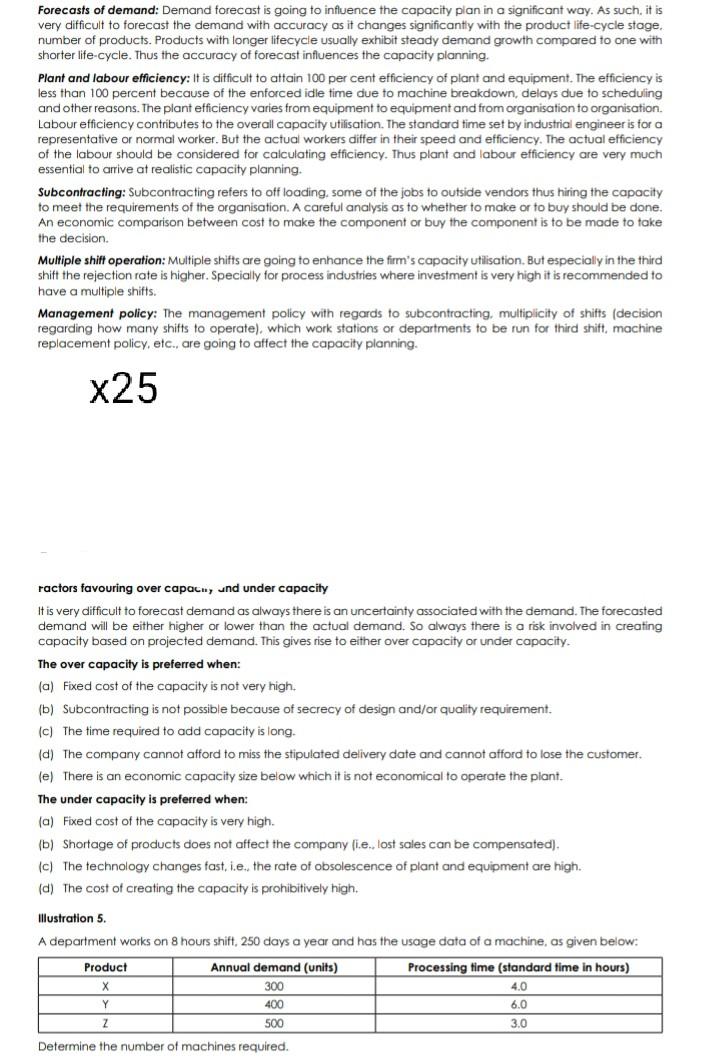Forecasts of demand: Demand forecast is going to influence the capacity plan in a significant….
Forecasts of demand: Demand forecast is going to influence the capacity plan in a significant way. As such, it is very difficult to forecast the demand with accuracy as it changes significantly with the product life-cycle stage. number of products. Products with longer lifecycle usually exhibit steady demand growth compared to one with shorter life-cycle. Thus the accuracy of forecast influences the capacity planning. Plant and labour efficiency: It is difficult to attain 100 per cent efficiency of plant and equipment. The efficiency is less than 100 percent because of the enforced idle time due to machine breakdown, delays due to scheduling and other reasons. The plant efficiency varies from equipment to equipment and from organisation to organisation Labour efficiency contributes to the overall capacity utilisation. The standard time set by industrial engineer is for a representative or normal worker. But the actual workers differ in their speed and efficiency. The actual efficiency of the labour should be considered for calculating efficiency. Thus plant and labour efficiency are very much essential to arrive at realistic capacity planning. Subcontracting: Subcontracting refers to off loading, some of the jobs to outside vendors thus hiring the capacity to meet the requirements of the organisation. A careful analysis as to whether to make or to buy should be done. An economic comparison between cost to make the component or buy the component is to be made to take the decision. Multiple shift operation: Multiple shifts are going to enhance the firm’s capacity utilisation. But especially in the third shift the rejection rate is higher. Specially for process industries where investment is very high it is recommended to have a multiple shifts. Management policy: The management policy with regards to subcontracting, multiplicity of shifts (decision regarding how many shifts to operate), which work stations or departments to be run for third shift, machine replacement policy, etc., are going to affect the capacity planning. X25 ractors favouring over capacu, und under capacity It is very difficult to forecast demand as always there is an uncertainty associated with the demand. The forecasted demand will be either higher or lower than the actual demand. So always there is a risk involved in creating capacity based on projected demand. This gives rise to either over capacity or under capacity. The over capacity preferred when: (a) Fixed cost of the capacity is not very high. (b) Subcontracting is not possible because of secrecy of design and/or quality requirement. (c) The time required to add capacity is long. (d) The company cannot afford to miss the stipulated delivery date and cannot afford to lose the customer. le) There is an economic capacity size below which it is not economical to operate the plant. The under capacity is preferred when: (a) Fixed cost of the capacity is very high. (b) Shortage of products does not affect the company fi.e., lost sales can be compensated). (c) The technology changes fast, i.e., the rate of obsolescence of plant and equipment are high. (d) The cost of creating the capacity is prohibitively high. Illustration 5. A department works on 8 hours shift, 250 days year and has the usage data of a machine, as given below: Product Annual demand (units) Processing time (standard time in hours) X 300 4.0 Y 400 6.0 Z 500 3.0 Determine the number of machines required
Forecasts of demand: Demand forecast is going to influence the capacity plan in a significant…